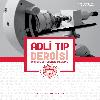OLFAKTÖR SİNİR YARALANMASI: BİR OLGU SUNUMU
OLFACTORY NERVE INJURY: A CASE REPORT
___
- 1. Miani C, Bracale AM, Moreschi C, et al. [Post-traumatic anosmia: description of a clinical case, proposal of a standardized protocol and medicolegal comments]. Acta Otorhinolaryngol Ital. 2002;22:142-149.
- 2. Fujii M, Fukazawa K, Takayasu S, et al. Olfactory dysfunction in patients with head trauma. Auris Nasus Larynx. 2002;29:35-40.
- 3. Kraus JF, Fife D, Ramstein K, et al. The relationship of family income to the incidence, external causes, and outcomes of serious brain injury, San Diego County, California. Am J Public Health. 1986;76:1345-1347.
- 4. Zusho H. Posttraumatic anosmia. Arch Otolaryngol. 1982;108:90-92.
- 5. Wu AP, Davidson T. Posttraumatic anosmia secondary to central nervous system injury. Am J Rhinol. 2008;22:606- 607.
- 6. Biacabe B, Nores JM, Bonfils P. [Description and analysis of olfactory disorders after head trauma. Review of the literature]. Rev Neurol (Paris). 2000;156:451-457.
- 7. Legg JW. case of anosmia following a blow. Lanset. 1873:659–660.
- 8. Sumner D. Post-Traumatic Anosmia. Brain. 1964;87:107-120.
- 9. Duncan HJ, Seiden AM. Long-term follow-up of olfactory loss secondary to head trauma and upper respiratory tract infection. Arch Otolaryngol Head Neck Surg. 1995;121:1183-1187.
- 10. Costanzo RM, Miwa T. Posttraumatic olfactory loss. Adv Otorhinolaryngol. 2006;63:99-107.
- 11. Balcı Y, Güzel S, Çetin G. Yeni Türk Ceza kanunu Çerçevesinde Düzenlenecek Adli Raporlar İçin Kılavuz.; İstanbul Haziran 2005.
- ISSN: 1018-5275
- Yayın Aralığı: 3
- Başlangıç: 1985
- Yayıncı: BAYT Yayıncılık
KAHRAMANMARAŞ SÜTÇÜ İMAM ÜNİVERSİTESİ TIP FAKÜLTESİ ADLİ TIP ANABİLİM DALINA 2009-2010 YILLARINDA
ERZURUM’DA 2008-2009 YILLARI ARASINDAKİ MEDİKOLEGAL ÖLÜMLERİN DEĞERLENDİRİLMESİ
Muhammed Ziya KIR, Hüseyin Çetin KETENCİ, Ahmet Ziver BAŞBULUT
OLFAKTÖR SİNİR YARALANMASI: BİR OLGU SUNUMU
M Mustafa ARSLAN, Ramazan KARANFİL, Yaşar ÇOKKESER, Cem ZEREN
ARI SOKMASINA BAĞLI İKİ ÖLÜM OLGUSU
Muhammed Ziya KIR, Hüseyin Çetin KETENCİ, Ahmet Ziver BAŞBULUT, Mücahit EMET, Mustafa UZKESER
KALP TAMPONADI: İSTANBUL’DA HEMOPERİKARDİUM KAYNAKLI ÖLÜMLER
Yavuz HEKİMOĞLU, A Sadi ÇAĞDIR, A Selçuk GÜRLER, D Oğuzhan MELEZ, Yalçın BÜYÜK
ÇOCUK YOĞUN BAKIM ÜNİTESİNDE TAKİP EDİLEN SUDA BOĞULMA VE BOĞULAYAZMA OLGULARI
Mehmet BOŞNAK, Gülseren BİLEN, Murat TUTANÇ, Ali KARAKUŞ, Cem ZEREN
YILDIRIM ÇARPMASINA BAĞLI KAFATASI KIRIĞI; BİR ÖLÜM OLGUSU
